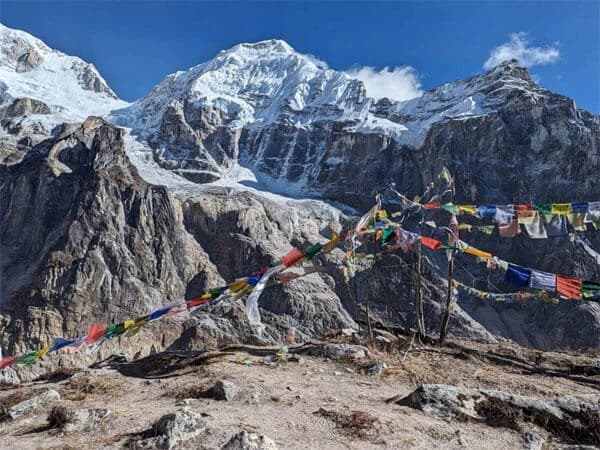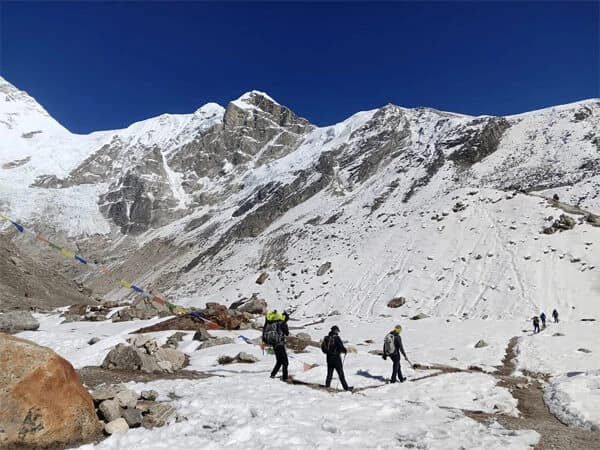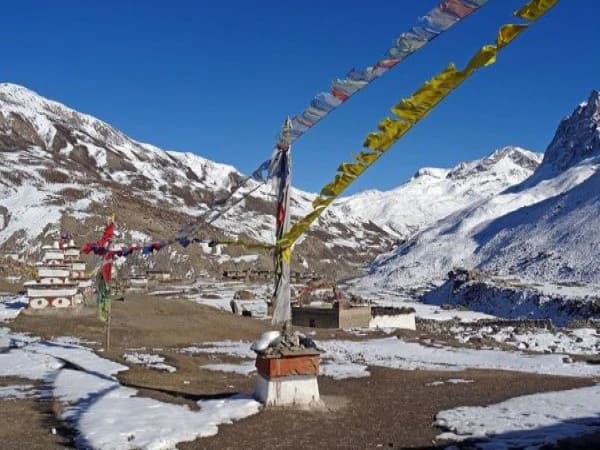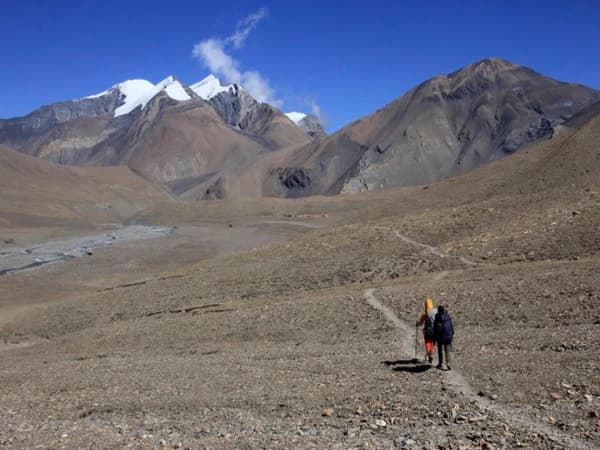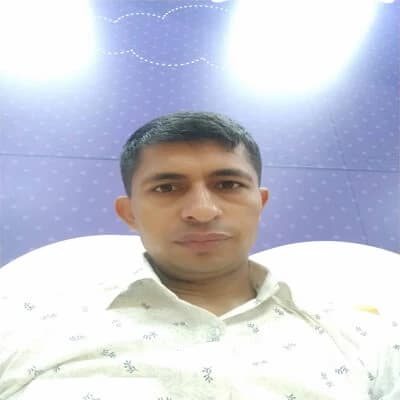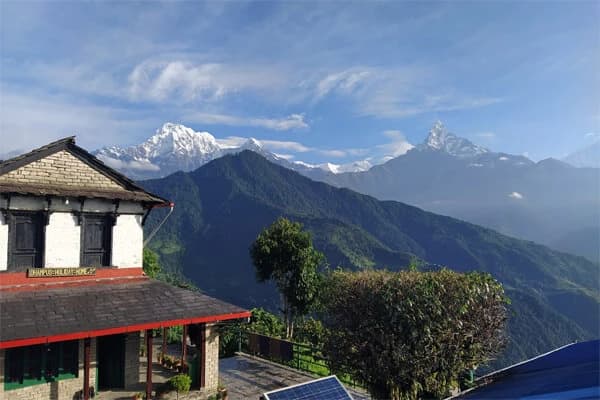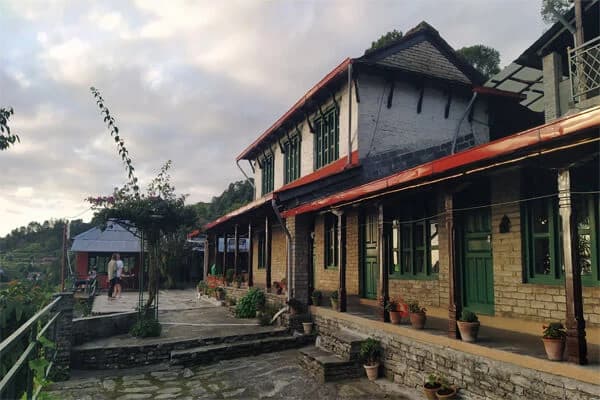The very first idea of the Great Himalayan Trail was conceive in the 1960s to promote the adventure tourism in the world. The proposed trail would be some 4,500km connecting the Himalayas of Pakistan, India, Nepal, Bhutan and Tibet, China. This route covers the geography from Nanga Parbat (8,126m) of Jammu & Kashmir and Namche Barwa (7,782m) of Tibet, China. Nanga Parbat is the world’s 9th highest peak whereas Namche Barwa is the easternmost section of the Great Himalayas.
The history of trekking in Nepal dates back to 1949 AD. A British adventurer, Bill Tilman got permission for several treks around the Kali Gandaki, Helambu Valley and Everest regions. In addition, Mount Annapurna (8,091m) was climbed on 3 June 1950 by a French expedition team led by Maurice Herzog. This ascent created a history of ever ascent to a peak above 8,000m. The successful ascent Annapurna Peak encouraged many daredevils around the world to try something higher than that!
The expedition team led by Sir Edmund Hillary and Tenzing Norgay reached the Everest Summit on 29 May 1953. Ever since then, mountaineering, peak climbing and trekking began to draw the attention of the adventure lovers. The presence of 8 among 14 eight-thousanders in the world, Nepal became the birthplace of adventure tourism. Initially, only Everest (8,848m) region and Annapurna (8,091m) region were the choice of the intrepid trekkers from worldwide.
In 2008, Robin Boustead and his team traversed from Far East to Far West Nepal. For them, it took 162 days to cover some 1,700km from Kanchenjunga region to the Far West Hilsa border. Then, in 2009, this east-west high altitude route got its name as the Great Himalayan Trail (also GHT), Nepal. The Great Himalayan Trail trek in Nepal is one of the world’s highest and longest trekking trails.
Nature and Culture of the GHT Nepal
Nepal Trekking through this route is the most adventurous journey in the Himalayas that one can get a lifelong experience. The regions that this longest trekking route of Nepal passes through reward you with an amazing memory of nature and culture. The snowcapped peaks stretching on the northern frontiers of Nepal with Tibetan Autonomous Region of China. Most of the regions have some restricted and conservation areas that have been promoting trekking in Nepal.
It offers you a wonderful diversity of wildlife, vegetation, lifestyle and culture as well. The Himalayan plants, animals and birds make this remote region quite worthy of visiting once in a lifetime. Sub-alpine and alpine regions house a large variety of vegetation from rhododendron to medicinal plants. When you make this trip in spring, the entire route is found colorful due to the rhododendron and other flowering plants blooming at fullest. The endangered animal species like snow leopard and red pandas make the challenging trek more fun.
You know, Nepal is a multi-ethnic, multi-cultural and multi-lingual country. It is a showcase of ethnic, cultural and lingual varieties despite its small area. The diverse culture ranging from the Sherpas of the Eastern Himalayas, Shamanism of Langtang Valley to the Bonpo Buddhist of Dolpo region are socio-cultural attractions. Ancient temples, monasteries, chortens and mani walls decorated with the most colorful prayer flags and wheels make you trekking in Nepal more colorful, too.
Adventure of the Great Himalayan Trail Nepal
The Great Himalayan Trail, Nepal takes you around 7 of the 8,000m+ peaks except Dhaulagiri (8,167m) in about 150 days. It is mostly recognized for adventure because only a handful of trekkers have traversed until the date. It is so because the trails in some sections are in very poor condition that it is hard to find them out. Likewise, it consists of many high Himalayan passes, which are completely technical.
The most technically tricky passes requiring climbing gears plus experience are 5 in the Eastern section. While traversing between Makalu Base Camp and Everest region, you have to cross Sherpani Col (5,164m), Amphu Lapcha Pass (5,845m) and West Col (6,135m). Tashi Lapcha Pass (5, 755m) should be crossed while entering into Rolwaling Valley from Everest region.
Similarly, Rolwaling Valley and Helambu Valley are connected by Tilman Pass (5310m). This pass is named after the first British explorer, Bill Tilman who formally began adventure tourism in Nepal since 1949. He attained several trekking permits in Annapurna, Rolwaling and Khumbu regions from the King. Among these passes, Sherpani Col is the highest point of the Great Himalayan Trail Nepal.
Because of the lack of proper food and accommodation services in all the stops of this trip, it is more adventurous. Because you cannot support yourself with logistics for all 150 days and more, it is hard to do this continuously. There are many sections where you are completely away from the human settlement areas. Therefore, you cannot do this as a complete teahouse trekking but combining with camping trekking.
To make the Great Himalayan Trail Nepal possible and more comfortable, the entire 1,700-kilometers-length is divided in to 10 major sections. The core objective of this blog is to give you the maximum useful information about the same 10 sections of the Great Himalayan Trial Nepal. Let’s take a quick look at them individually.
Kanchenjunga Region
Kanchenjunga is the eastern most popular point of the Great Himalayan Trail Nepal that is named after Mt. Kanchenjunga(8,586m). It is the 3rd highest peak in the world located between Nepal and Sikkim, India. According to the Tibetan dialect, “Kanchenjunga” means “Five Treasures of Snow”, which refers to the five peaks of the Kanchenjunga Massif.
The diverse terrain, green forests, lush valleys and glittering snowcapped mountains are the natural rewards of this trek. You can see a large variety of flora and fauna of Kanchenjunga Conservation Area Project (KCAP).
This region is home for the Kirant people. Therefore, Rai and Limbu people are the major inhabitants as indigenous ethnic communities here. Due to the remoteness, the lifestyle, culture and tradition are still untouched by modern technology and tools. The indigenous culture and tradition including Limbu Cultural Heritage Trail are the cultural beauties of this trek.
The major variants of Kanchenjunga region trekking areKanchenjunga South and North Base Camp trek, Kanchenjunga Circuit trek, Kanchenjunga Short trek and Kanchenjunga Makalu trek.
Makalu Barun
This section is named after Mount Makalu (8,463m) that lies in the Mahalangur Himalayan Range. It is located between Kanchenjunga region and Everest region. It is popular for Makalu Barun Conservation Area (MBCA) which hosts varieties of flora and fauna, is the central attraction of this region. MBCA hosts from tropical, sub-tropical, lower and upper temperate, sub-alpine to alpine forests.
This conservation area is the home for almost 3,128 species of flowering plants including 25 rhododendron, hundreds of orchid, aromatic and medicinal herbs including bamboo, oak and fodder trees.
Similarly, MBCA boasts nearly 315 species of butterflies, 43 reptiles, 16 amphibians, 78 fish species and 88 species of mammals. Snow leopard, marmot, Himalayan thaar, Asian Golden cat, musk deer, flying squirrel, barking deer, clouded leopard are the animals adorning MBCA.
The mountain Rai, Limbu, Sherpa, Tamang and other mixed ethnic communities reside in this region. Their unique lifestyle, culture and tradition are the prizes of this trek. The popular variants of Makalu region trekking are Makalu Base Camp trek, Arun Valey trek and Lumba Sumba trek.
Rolwaling & Everest Region
The third major section of the Great Himalayan Trail Nepal is Rolwaling & Everest region. This region has been the central attraction of the international trekkers as there are 3 eight-thousanders including Mt. Everest (8,848m). Mt. Lhotse (8,516m) and Mt. Cho Oyu (8,201m) are the other two 8,000m+ peaks.
This section is popular for Sagarmatha National Park, the highest altitude conservation area in the world. Due to its biodiversity, it has been included in the UNESCO World Heritage List.
The ancient monasteries, chortens and mani walls are the cultural attractions of this section. This region is the home of the Sherpas, who are influenced by the Tibetan Buddhist lifestyle, culture and tradition. You can also visit the highest altitude hotel, Everest View Hotel (3,880m).
The popular treks to Everest region are Everest Base Camp trek, Everest Gokyo Lakes trek, Everest Cho La Pass trek and Everest Three High Pass trek.
Rolwaling Valley section is the home of the Yeti that the indigenous people still narrate the story of this abominable creature. The least visited region of Nepal, this section is highly populated by the Tamang, Sherpa, Gurung and Thami people.
As this valley is close by Gaurishankar Conservation Area, you can find a large variety of birds and animals here. The seasonal activities like bird watching tour, snow skating, peak climbing are the prime activities of this region.
Rolwaling Valley trek, Rolwaling Tashi Lapcha Trek, Tso Rolpa Lake trek and Rolwaing Tashi Lapcha Pass trek are some of the popular packages. Likewise, Jiri Everest Base Camp trek is the most fascinating trip. It is the opportunity to follow the footprints of Sir Edmund Hillary and Tenzing Norgay, the first ascenders of the Everest Summit.
Langtang & Helambu
Langtang & Helambu is the 4th section of the Great Himalayan Trail Nepal that is the closest trekking destination from Kathmandu. You enter into this classic valley of Tamang and Sherpa people, you need to cross Tilman Pass (5,310m).
Located in Lantang National Park, this region is popular for a large variety of flora and fauna. It is also a top destination for peak climbing in Nepal. Yala Peak climbing and Paldor Peak climbing are very popular among the adventure lovers.
It is also famous for Tamang Shamanism, the traditional healing system that existed even before medical science and medicines. Ancient monasteries, chortens and mani walls are commonly found in this region. As it is close to Tibetan Plateaus, we find a high influence of Tibetan Buddhist culture and tradition.
The biodiversity, cultural variety and local organic cheese are the originality of Langtang region trekking. It is best known for Langtang Valley trek, Langtang Helambu Valley trek, Langtang Gosainkunda Trek, Tamang Cultural Heritage Trail and many more.
Manaslu & Ganesh Himal
Another prominent section of the Great Himalayan Trail Nepal is Manaslu & Ganesh Himal. You have to cross a Shamanic village called Gatlang (2,380m) of Langtang region to enter into Ganesh Himal (7,422m) region. Ganesh Himal trek is also called Ruby Valley trek as you can find this invaluable stones in their raw form. It is a fascinating trekking destination of Nepal located quite closer to the Kathmandu Valley.
Manaslu region has been name after Mount Manaslu (8,163m), the 8th highest peak in the world. Mt. Manaslu is the most difficult mountain in the world for expedition in Nepal. Therefore, it is often call the Killer Mountain. Manaslu Circuit trek is an amazing combination of nature, culture and adventure all at once.
Manaslu Conservation Area Project (MCAP) is a home for large species of plants, animals and birds. Most importantly, 25 of Nepal’s 30 rhododendron species are found in this conservation area. Hence, making Manaslu trek in spring lets you witness this Himalayan region in its best colour.
Manaslu Tsum Valley trek is another variant of Manaslu trek. It rewards you with a unique showcase of Gurung and the Tibetan Buddhist socio-cultural aspects. The ancient monasteries as old as 800 years old, chortens and mani walls make this land more vibrant.
It has been believe that the Chinese scholar and saint Milarepa meditated in this region. This is why, there is a natural cave name as the Milarepa’s Cave (also call the Piren Phu or Pigeon’s Cave). The footprints of Milarepa are still preserve inside the cave.
The polyandry is another rare culture still prevalent in Manaslu region. Likewise, as the people over here follow the Tibetan Buddhism, killing animals and birds is not allow here. It is therefore, call the Hidden Valley of Happiness because despite its remoteness, people are happy with their cultural identity.
Larkya La Pass (5,106m) is the highest point of Manaslu Circuit Tsum Valley trek. This non-technical pass connects this region with Annapurna & Mustang region.
Annapurna & Mustang
Annapurna & Mustang region is perhaps the most popular among the international trekkers. It is because Mt. Annapurna (8,091m) was the first 8,000m+ peak to have ascended. The team led by a French adventurer Maurice Herzog climbed on June 3, 1950.
Mt. Annanpurna is a historical peak in the beginning of the adventure tourism in Nepal. Therefore, it has become the Number 1 trekking region in Nepal. Almost one third of the total international trekkers make their trip around Annapurna region.
It is the most developed tourist destination of Nepal because of its geographical friendliness as well. This region is the home for Gurung, Magar, Thakali and mixed ethnic communities. You begin the trek from the Marsyangdi River Valley and end at the Kali Gandaki Gorge Valley.
In a sense, Annapurna Circuit trek is the abode of natural diversity and cultural variety. The highest place is Thorung La Pass (5,416m) that takes you towards Muktinath region.
Upper Mustang trek is one of the most done restricted area trekking in Nepal. This is the last forbidden kingdom of the Himalayas still standing as the natural and cultural mystery among the tourists. Upper Mustang region lies in the rain shadow of Annapurna and Dhaulagiri (8,167m) Massifs. So, it is possible to make Upper Mustang trek in summer season as well.
The bizarre landscapes that resembles with the Tibetan Plateaus, the Sky Caves, Lo Manthang, the ancient monasteries are the major attractions of this region. Moreover, Mustang Tiji Festival trek lets you experience the most colorful celebration of this part.
Although it is an offbeat trek, it is completely a teahouse trekking. If you prefer, you can also do camping trekking to Upper Mustang region.
Dolpo Region
Kagbeni, the gateway to Upper Mustang trek, connects Annapurna & Mustang region with Dolpo region. Dolpo is the gem of the Nepalese tourism and an outstanding section of the Great Himalayan Trail Nepal.
Moving ahead from Kagbeni, you cross Jungben La (5,550m) and Niwas La (5,120m) to reach Chharka Bhot (4,302m). From Chharka Bhot, Upper Dolpo region begins.
Dolpo region has been divide into two parts: Upper or Inner Dolpo and Lower Dolpo. Upper Dolpo trek takes you to the unexplored valleys of western Nepal close to Tibetan Plateaus. The Bonpo Buddhist culture and tradition is the most unique feature of this region.
Lower Dolpo trek (also Dolpo Circuit trek) takes you around the conservation of Nepal. Shey Phoksundo National Park is the largest and only protected area in the Trans-Himalayan region of Nepal. You can also visit the deepest lake of Nepal, Shey Phoksundo Lake during this trip.
While following the Great Himalayan Trail Nepal route through Upper Dolpo region, you will reach Dho Tarap Village (4,220m). This village is one of the highest altitude village having permanent settlement all around the year. You will also visit some of the oldest Bonpo Buddist shrines like Shey Gompa while moving along this route.
Great Himalayan Trail of Rara Lake & Jumla
From Naulighat, the Great Himalayan Trail Nepal route moves further towards the Rara Lake & Jumla section via Dab Village. The Rara Lake is the largest lake of Nepal located at 2,990m is the home for some endemic fish and frog species of Nepal.
Rara National Park is the home for a large variety of flora and fauna that can adjust in the higher altitude. Rara Lake trek takes you to an extract of heaven on Earth! Although it is geographically remote, now you can also do Rara Lake Overland tour to ease the physical labour.
Jumla has been famous for the Sinja Valley, the very place from where the modern Nepali language was originate. It used to be a different kingdom before the unification campaign of Nepal. Still today, you can find fossils of cultural and religious properties of this old kingdom. Because of its cultural importance, it has been enlisted under the UNESCO Tentative List.
Jumla is famous for walnuts as well as organic apples and their products like liquor, pickle, etc. The rice of Jumla is also famous as organic all over Nepal and is known as the Marsi Chamal!
Great Himalayan Trail Humla
Humla is the second far western section of the Great Himalayan Trail Nepal route. It is the exit point for holy Kailash Mansarovar Yatra overland or trekking as well. Although it is one of the most remote region of Nepal, it is gaining its popularity day by day. The publicity of the natural and cultural wonders has drawn the attention of the avid trekkers from all around the world.
People from different castes and religions are living in this Himalayan district by maintaining social harmony for ages. Hinduism, Buddhism and Shamanism are some of the most striking features. You can find more than 1,000 years old Rizing Ling Gompa in Hulma Karnali.
Limi Valley trek is the most done trekking to Humla Great Himalayan Trail Nepal route. It is hidden valley of the Far Western region offering an amazing experience of natural and cultural varieties.
The Far West for Great Himalayan Trail
The last section of the Great Himalayan Trail Nepal route is the Far West part of the nation. It shares its border with the Tibetan Autonomous Region of China. As most of the part of this region is barren, the settlement areas are very scanty. The notable trip of the Far West section of the Great Himalayan Trail Nepal is Api Himal Base Camp trek. This is the least made trekking in Nepal although it is rich in nature and culture.
Trekking to Api Himal Base Camp (4,000m) rewards you with the amazing Himalayas of the Far West and some of India’s. Api (7,132m), Nampa (6,929m) and Nobaye (6,808m) lie in Api Nampa Conservation Area. Extended in Darchula, Bajura and Bajhang, this conservation area is the home for a large species of wildlife and vegetation.
Likewise, Khaptad National Park is also another attraction making this isolated region worthy of visiting. Established in 1984, this protected area has been dedicate to a Hindu Saint Khaptad Baba, who spent nearly 50 years in hermitage. This park covers some areas of Bajhang, Bajura, Achham and Doti. This national park has conserved 567 species of flora, 23 mammals, 287 birds including 23 species of amphibians and reptiles.
Conclusion: Great Himalayan Trail Trekking in Nepal
The GHT Nepal is the “Trail of trails!” It covers all the major trekking regions of Nepal from East to West. Yes, it may be difficult to manage 150 days to do all the sections at once. The GHT Nepal itinerary could be customize up to 105 days for your comfort. Or, you can plan to cover all the regions in different phases as well.
Nepal Trekking Routes helps you decide which sections to do when. We have organized the GHT Nepal trek a few times as only limited trekkers do this trek due to the lack of vacation in Nepal.


